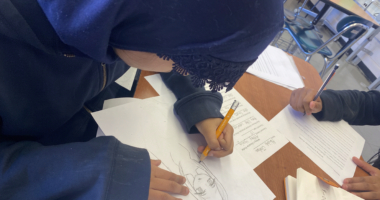In my first seminar with Community-Word Project’s Teaching Artist Training & Internship Program (TATIP) back in October, our first task was to answer questions on chart paper, which was posted around the room. Afterwards, with anticipation, we navigated around our fellow new trainees while musing at one anothers’ responses on the newly decorated “graffiti walls.”
This exercise gave us an opportunity to be honest about our greatest fears about teaching, what we need to be creative instructors, what we feel least prepared for in teaching, and more.
I was struck by how heard I felt during this process. The act of writing out the bumbling questions, anxieties, and hopes for our TATIP training on paper, knowing that our trainers would see them, and seeing the similarities in our peers’ responses was immensely calming. It helped us organize thoughts and questions as we entered the start of class.

While our group reflected on the walls, Patti described the ways in which graffitti walls could be used as a tool for assessing the room as well as a warm up to get students ready to tackle a certain theme or inquiry question.
Trying out Graffiti Walls in the classroom…
This Spring, Intisar Hamilton and I are teaching artists at a middle school in South Philadelphia with Art Sanctuary. When our 7th grade students come to our class after lunch, they are energetic, sweaty, and lugging full backpacks from the school yard.
After a few minutes of chaos as students transition from outdoor time to art time, we begin using those Graffiti Walls!
The graffitti walls have transformed the start of class, just as they did for me and my co TATIP trainees several months ago.
Our graffiti walls prompt students to answer questions such as:
What does Leader mean to you?
What do you treasure?
What is another word for ‘action’?
What do you hope for?
Where do you hope to travel?


They are also given prompts like:
I think
I wonder
I am
I wish

Now, 5 weeks into our residency, our students come into class eager to grab a marker and get to the walls. They often ask if they’ve missed any, hoping for another question. They move about the room – sometimes answering the prompts with humor & imagination; other times with reflection & honesty. It is my first experience witnessing ritual become ritual in my art classroom. This ritual gives them a small spot to get some thoughts out in public before diving into class.
In a large class, with limited time and lots of attention paid to our visual arts activities, the graffiti walls have enabled us to learn about our students, engage them in specific themes, and get out some pre-teen energy on the walls around them.
-Martha OC, TATIP Trainee (2016-17)



